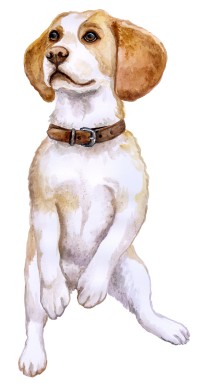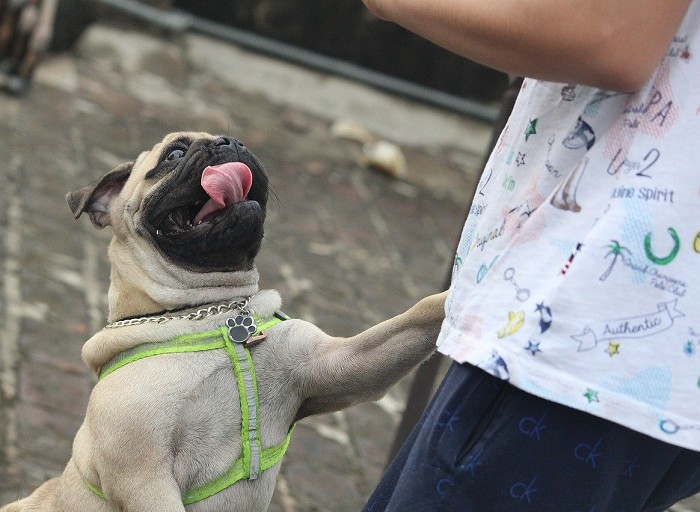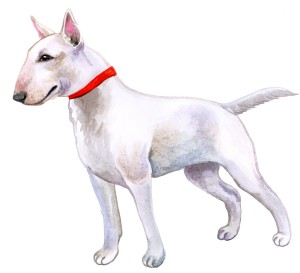Teach your dog to stop jumping on people
By Michele Welton, Dog Trainer, Breed Selection Consultant, Author of 15 Dog Books
 Jumping on people looks cute when a pup is 3 months old, but it becomes such a serious behavior problem that you shouldn't allow jumping even in a young puppy.
Jumping on people looks cute when a pup is 3 months old, but it becomes such a serious behavior problem that you shouldn't allow jumping even in a young puppy.
A jumping dog:
- tears clothing
- leaves muddy pawprints on clothing
- scratches people with sharp toenails
- nips people (even accidentally from excitement)
- causes toddlers or slight/frail people to stumble or fall
Along with the damage that can be done to people, jumping creates an over-excited mindset in the dog, which is the very opposite of the calm mindset we're trying to teach.
Even a physically active dog feels more secure when he's in a calm, relaxed state of mind.
Perhaps you're thinking, "But my dog only jumps on me, not on other people."
Even so, he's practicing an excitable mindset that is psychologically stressful. And God forbid, if anything happened to you, and your pup needed to be re-homed, fewer people will adopt an excitable jumping dog.
So you really should stop this behavior as soon as it starts. It's not safe or considerate of other people. And it's definitely not good for your pup's all-important state of mind.
Don't try to stop jumping with the following techniques
- Don't put your hands on a jumping dog – not even to push him off. Because YOU might think you're pushing him off, but HE often views it as petting or fondling. From his perspective, those consequences are positive. He's getting attention and petting when he jumps. So keep your hands off him.
- Don't turn your back on a jumping dog. That only teaches him to sneak around to your frontside before he jumps. Other pups don't even care – they're just as happy to jump against your backside and knock you forward.
Three effective corrections for jumping
![]() The first effective technique to extinguish jumping is to raise your knee as the dog jumps. AS the pup starts his jump, raise one knee as though you were doing a high-step march in a parade. A larger dog will bump against your raised knee, while a smaller dog will bump against your raised shin, ankle, or foot.
The first effective technique to extinguish jumping is to raise your knee as the dog jumps. AS the pup starts his jump, raise one knee as though you were doing a high-step march in a parade. A larger dog will bump against your raised knee, while a smaller dog will bump against your raised shin, ankle, or foot.
Don't kick him! Just a bump. You want him to conclude, "Hmm, that wasn't the outcome I was hoping for. An uncomfortable bump and I didn't even get petted!"
Yes. Exactly. If you don't want a dog to jump, you need him to conclude that jumping is yucky to do.
Oh, and don't make eye contact as you raise your knee. Eye contact is positive attention. Just watch the pup out of the corner of your eye so you'll be ready with another knee raise in case he tries a second jump.
Only when he has settled down (wait a good 10 seconds) should you look at him and acknowledge him. In a calm voice, say, "Hello, Jake." If he takes that as encouragement to jump again, repeat your knee raise but this time wait a little longer before acknowledging him.
You want him to learn this pattern: "jump → yucky bump + no attention."

![]() The second effective technique to extinguish jumping is a sideways tug of the leash. If you remember from my other articles, a pup with behavior problems should be on a leash inside your house until those problems have been resolved. Jumping definitely qualifies as a behavior problem!
The second effective technique to extinguish jumping is a sideways tug of the leash. If you remember from my other articles, a pup with behavior problems should be on a leash inside your house until those problems have been resolved. Jumping definitely qualifies as a behavior problem!
Grasp the leash about a foot from his collar and quickly move your hand toward the jumping dog (to create a little slack). Then the actual correction is a tug sideways and parallel to the ground, which provides a negative consequence to the jumping.
For a sensitive puppy, the movement of the leash can be just a pull that puts him a little off-balance. For a determined jumper, it should be a firm "popping" tug that really gets his attention.
![]() The third effective technique to extinguish jumping is to startle the pup in the act of jumping. Being startled is a negative consequence to some (but not all) pups. Try these corrective techniques: a spray of water, a shrill sound from the Barker Breaker, or a puff of air from the Pet Convincer or Pet Corrector.
The third effective technique to extinguish jumping is to startle the pup in the act of jumping. Being startled is a negative consequence to some (but not all) pups. Try these corrective techniques: a spray of water, a shrill sound from the Barker Breaker, or a puff of air from the Pet Convincer or Pet Corrector.
The difficulty here is that you need to have the device in your hand when the pup jumps. So you should stage a set-up in which you hold the device behind your back out of his sight. Then "present yourself" to your pup in a way that might cause him to jump.
 Don't pat your leg or your chest trying to goad him into jumping! That would be unfair.
Don't pat your leg or your chest trying to goad him into jumping! That would be unfair.
But certainly you can stand still facing him, with one arm hanging naturally at your side and the other hand behind your back. If he jumps, spray the water or activate the device. Many pups will veer away and not want to repeat the jump.
What if your puppy jumps on other people?
You might have helpful friends who would be willing to do the knee-raise technique. But you can't count on all your guests doing that. Think of your great-grandmother. Or Uncle Henry with his arthritis. Or your 4-year-old niece.
No, YOU should be the one to correct your pup for jumping on other people.
Until this problem is solved, a jumping dog should be on a leash whenever other people are around.
Either you're holding the leash or he's dragging it. Then you can quickly gain control and administer the appropriate degree of tug if he jumps on anyone. Remember, a gentle tug for very young or sensitive pups, a firmer tug for more determined pups.
Alternatively, if your dog is deterred by a spray of water, sound device, or puffed air device, keep them close at hand.
One of the most valuable lessons you can teach your pup is that he is praised and rewarded for calmness, and corrected for excitability. This overall state of mind will stay with him throughout his life, so make sure you guide him down the right path!
My best-selling books – now available FREE on my website
 Respect Training For Puppies: 30 seconds to a calm, polite, well-behaved puppy is for puppies 2 to 18 months old. Your puppy will learn the 21 skills that all family dogs need to know. Click here to read for free.
Respect Training For Puppies: 30 seconds to a calm, polite, well-behaved puppy is for puppies 2 to 18 months old. Your puppy will learn the 21 skills that all family dogs need to know. Click here to read for free. Teach Your Dog 100 English Words is a unique Vocabulary and Respect Training Program that will teach your adult dog to listen to you and do what you say. Click here to read for free.
Teach Your Dog 100 English Words is a unique Vocabulary and Respect Training Program that will teach your adult dog to listen to you and do what you say. Click here to read for free. 11 Things You Must Do Right To Keep Your Dog Healthy and Happy helps your dog live a longer, healthier life. Get my honest advice about all 11 Things before you bring home your new puppy, because some mistakes with early health care cannot be undone. Click here to read for free.
11 Things You Must Do Right To Keep Your Dog Healthy and Happy helps your dog live a longer, healthier life. Get my honest advice about all 11 Things before you bring home your new puppy, because some mistakes with early health care cannot be undone. Click here to read for free.
